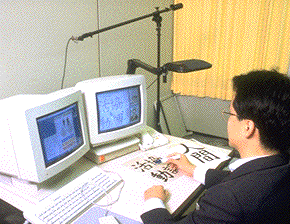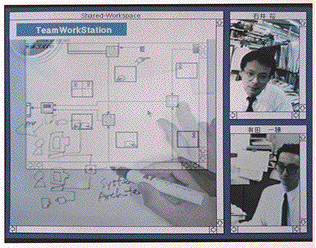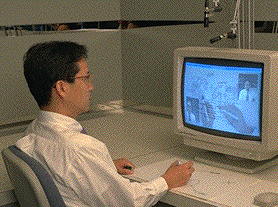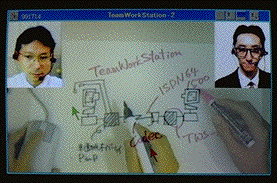![]()
![]()
People do a lot of their work without computers, or using different
tools on different computer systems, and have developed their
own work practices for these situations. Even in a heavily computerized
individual workplace, users often work both with computers and
on the physical desktop. Neither one can replace the other. For
example, printed materials such as books and magazines are still
an indispensable source of information.
Therefore, when designing realtime shared workspaces, depending
on the task and the media of the information to be shared (paper
or computer file), co-workers should be able to choose either
computers or desktops, and to switch between them freely. One
person's choice should be independent of the other members' choices.
Group members should be able to use a variety of heterogeneous
tools (computer-based and manual tools) in the shared workspace
simultaneously. To realize such a seamless shared workspace, we
designed TeamWorkStation-1 (TWS-1).
 |
 |
|
The key design idea of TWS-1 is a "translucent overlay" of individual
workspace images. TWS-1 combines two or more translucent live-video
images of computer screens or physical desktop surfaces using
a video synthesis technique. Translucent overlay allows users
to combine individual workspaces and to point to and draw on the
overlaid images simultaneously. We chose video as the basic medium
of TWS because it is the most powerful for fusing presentations
of a variety of traditionally incompatible visual media such as
papers and digital documents. |
|
 |
 |
|
Since TWS-1 was designed for laboratory experiments to verify
the concept of seamless shared workspaces, we did not pay much
attention to the number of cables or the communication bandwidth.
As a result, the system configuration became complex and difficult
to maintain. This complexity prevented us from conducting the
field tests using publicly available digital networks, and motivated
us to start designing a completely new system, TeamWorkStation-2
(TWS-2). |
|
For more information about this project, please refer the following
papers and video.
Ishii, H., Kobayashi, M. and Arita, K., "Iterative Design of Seamless
Collaboration Media," Communications of the ACM (CACM), Special Issue on Internet Technology, ACM, Vol. 37, No. 8, August
1994, pp. 83-97.
Ishii, H., Arita, K., and Yagi, T., "Beyond Videophones: TeamWorkStation-2
for Narrowband ISDN," Proceedings of Third European Conference
on Computer-Supported Cooperative Work (ECSCW '93), Kluwer Academic Publishers, Dordrecht, Netherlands, September
1993, pp. 325-340.
Ishii, H., "Translucent Multiuser Interface for Realtime Collaboration," IEICE Transactions on Fundamentals of Electronics, Communications
and Computer Science, Special Issue on Next Generation Human Interface, Institute
of Electronics, Information and Communication Engineers of Japan
(IEICE), Vol. E75-A, No. 2, February 1992, pp. 122-131.
Ishii, H., and Miyake, N., "Toward An Open Shared Workspace: Computer
and Video Fusion Approach of TeamWorkStation," Communications of the ACM (CACM), Special Issue on CSCW, ACM, Vol. 34 No. 12, December 1991, pp.
37-50.
Ishii, H. and Arita, K., "ClearFace: Translucent Multiuser Interface
for TeamWorkStation," Proceedings of Second European Conference
on Computer-Supported Cooperative Work (ECSCW '91), Amsterdam, 25-27 September 1991, pp. 163-174.
Ishii, H., "TeamWorkStation: Towards a Seamless Shared Workspace,"
Proceedings of Conference on Computer-Supported Cooperative Work
(CSCW '90), ACM SIGCHI and SIGOIS, Los Angeles, 7-10 October 1990, pp.
13-26.
Ishii, H. and Ohkubo, M., "Design of TeamWorkStation: A Realtime
Shared Workspace fusing Desktops and Computer Screens," Proceedings
of Conference on Multi-User Interfaces and Applications, Ed. S.
Gibbs, North-Holland, IFIP WG8.4, Crete, Greece, 24-26 September 1990, pp. 131-142.
Ishii, H., Arita, K., and Kobayashi, M., "Toward Seamless Collaboration
Media: From TeamWorkStation to ClearBoard," SIGGRAPH Video Review,
CSCW '92 Technical Video Program, Issue 87, Item 6, ACM, New York, 1992.
Home Page